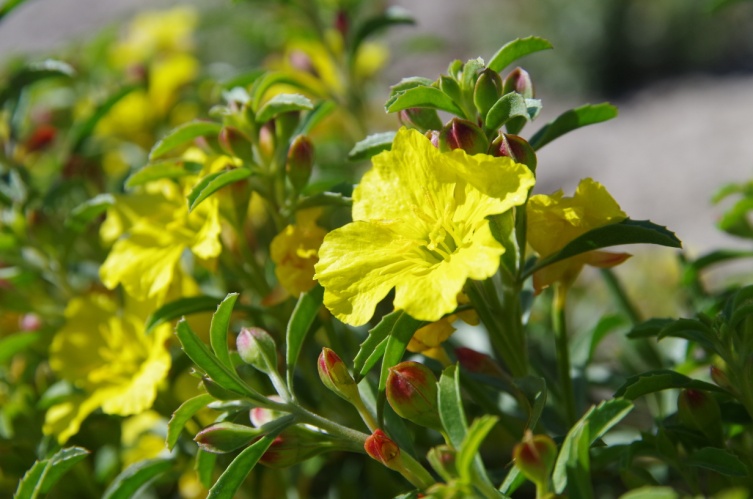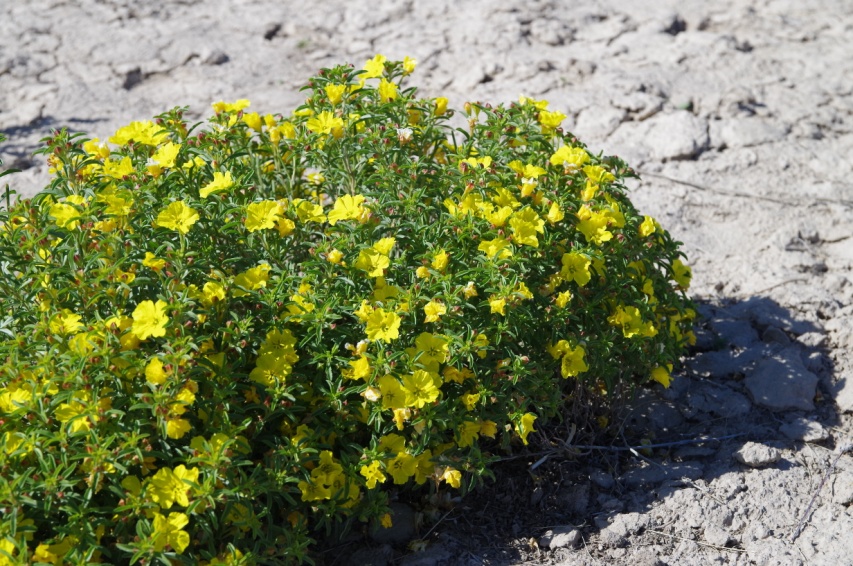Yellow Sundrops in the Landscape


Stephen Love, University of Idaho
Scientfic Name: Calylophus serrulatusCommon Name: Yellow sundrops, dwarf sundrops
Description: Yellow sundrops is one of the best daytime blooming, yellow-flowered evening primroses. The species is classified as a sub-shrub, although in cold climates it tends to die back in winter almost to the woody crown. It is moderately long-lived. Plant form is reminiscent of a tiny bush. Leaves are cauline, growing only along the numerous slender branches. Mature plants are typically 8 to 12 inches tall and up to 18 inches wide. The bright green leaves are ovate with short petioles and serrated edges. The flowers are relatively small for a primrose, about 1 ½ inches across. Although each flower is short-lived, a continuous supply of new buds keeps the plants covered with yellow from June into October. Yellow sundrops has the charm to be used in any part of the landscape and makes a good subject for a xeric rock garden, low bed, or border.
Native Habitat: Calylophus serrulatus is primarily a plant of the central and northern Great Plains. It makes its way into the Intermountain Region in central Wyoming, central Colorado, and northern Arizona and New Mexico. This species inhabits dry prairies, meadows, and hillsides often on calcareous substrates. In mountainous habitats on the Colorado Plateau, yellow sundrops grows at elevations ranging from 4,000 to 7,000 feet.
Cultural Requirement
Soil: Tolerates a wide range of soils, including clays and those with high pH, but requires dry or well-drained conditions to ensure a long life span.
Moisture Tolerance: Thrives under very dry to moderately dry conditions. Bloom period is extended with occasional supplemental irrigation.
Sun/Shade/Preference: Prefers full sun but grows well and blooms adequately in light shade.
Transplanting: Young seedlings transplant easily, both from pot to pot and from pot to garden. Can withstand long-term culture in pots up to one gallon size.
Propagation: Best grown from seed. Requires 6 to 8 weeks of cold stratification to optimize germination. Usually expresses a high rate of germination. Seedlings are easy to handle and transplant nicely when they have 4 to 6 true leaves. Yellow sundrops can be propagated using cuttings, but this method is rarely used.
Maintenance (pruning, fertilization, deadheading, division, irrigation, etc): Yellow sundrops is almost maintenance free. In the spring, cut back old growth to near the crown. Spent flowers are self-cleaning and no dead-heading is required. Apply supplemental summer irrigation every 2 to 3 weeks to extend the bloom period. Added fertilizers are seldom needed.
Insect, disease, or other problems: Yellow sundrops has no diseases or pests of consequence.
Landscape Value
Use in the Landscape: Yellow sundrops is a tidy plant that can be used for a number of effects in the landscape. It can be used for foundation plantings, mass planted as a groundcover, or arranged in mixed beds and borders. The small form makes it ideal for a rock garden. This plant is amenable to either formal or naturalized designs.
Weediness/Invasive Potential: Yellow sundrops is not rhizomatous. In research plots in Idaho, it has seldom produced volunteer seedlings although Robert Nold, in his book “High and Dry”, describes a very weedy habit for this species in his garden. This tendency should be weighed when considering this plant for landscape applications.
Foliage: The small, bright green, serrated leaves are all cauline, meaning they grow only along the slender stems. An abundance of stems gives the plant a dense habit. Foliage remains attractive season-long.
Flower: The 4-petalled flowers are small (1 to 1 ½ inches across), bright yellow, and showy. Each flower lasts for only one day, but a profusion of new buds provides summer-long color. The flowers open during daylight hours and close at night.
Timing: June-October.
Fruit: The fruits are inch-long, cylindrical capsules. Each contains numerous tiny, dark brown seeds.
Form: Yellow sundrops plants have a moderately dense mounded form.
Texture: Moderately fine.
Ultimate Size: Mature plants grow 8 to 12 inches tall and 18 or more inches wide.
Rate of Growth: Yellow sundrops plants are relatively fast growing and develop an attractive leaf mound within a few months. They often bloom in pot culture and usually bloom profusely the first year after transplanting to the garden.
Suggested Plant Partners: Mix yellow sundrops with small xeric shrubs or sub-shrubs and small to medium-sized wildflowers, including Amorpha nana, Salvia dorii, Eriogonum wrightii, Eriogonum niveum, Penstemon labrosus, Penstmeon pinifolius, Machaeranthera coloradoensis, Artemisia michauxiana, Agave parryi, Potentilla uniflora, and Schizachyrium scoparium.
Availability: Occasionally available as potted plants from local or mail-order nurseries specializing in native plants. Seed can be purchased from native plant seed suppliers.
Cultivars: ‘Prairie Lode’ is a readily available cultivar released as part of the Plant Select program in Colorado.
References:

